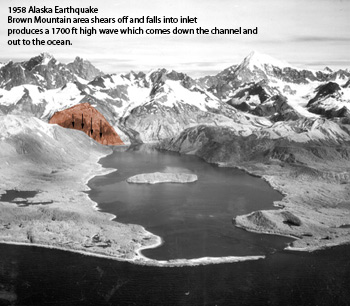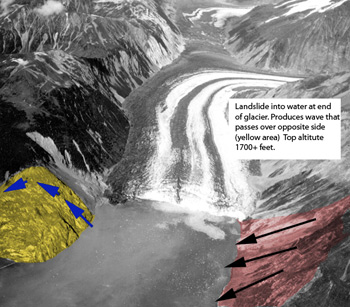Storms - high magnitude storms are dangerous for several reasons ...
1.) Storm Serge which is the inland rush of higher than normal tides can flood areas and bring surf further inland. The salt water is far more corrosive to human "objects" than normal rain run-off.
2.) Large waves will release more energy to the land and cause increased and often catastrophic erosion over a short time. They can topple homes, or undercut foundations not designed to withstand them.
A high speed, long wavelength wave, created by a major geologic event. Could be an earthquake or underwater avalanche. Tsunamis can travel at speeds in excess of 950 km per hour in open water.
They appear harmless when viewed in the open ocean. They have a very wide wavelength and not much elevation at sea. But when they strike land, they can quickly rise to 30 m or more as they hit the shore (that's 90 ft.). Moving faster than a speeding car. Their velocity does drop as they move to shore.
1.) 1992 - The December 1992 Tsunami in Indonesia 25 m wave height (75 + feet)
2.) 1992 - September 1992 Tsunami in Nicaragua (8 -15 m wave height) (24 - 45 feet)
3.) On July 12. 1993, a powerful earthquake west of Hokkaido in the Sea of Japan unleashed a tsunami that devastated nearby Okushiri Island. For a video of the devistation and an animated look at what happened visit the USC Tseunami Research Center ...
4.) For more news on the recent Tseunami of March 28, 2005 also see their research center ... and you thought they only played great football!
Under cutting of shoreline cliffs can lead to landslides which can carry shoreline homes with them or just collapse on beach houses.
In 1958 a landslide in an Alaskan bay triggered by an earthquake dropped a wall of rock into the fjord. The wall of water created by the rock rose up to 1700 feet on the opposite side. It wiped all of the trees off of the rock upto the pint it hit, and cleaned off all of the old rock tallus.
It continued down the bay and over the center island, and finally over the spit of land at the end and on into the ocean.


| NEXT | TOC | PREV |